A Vermont Valley Is Back to the Future and Back to the Land
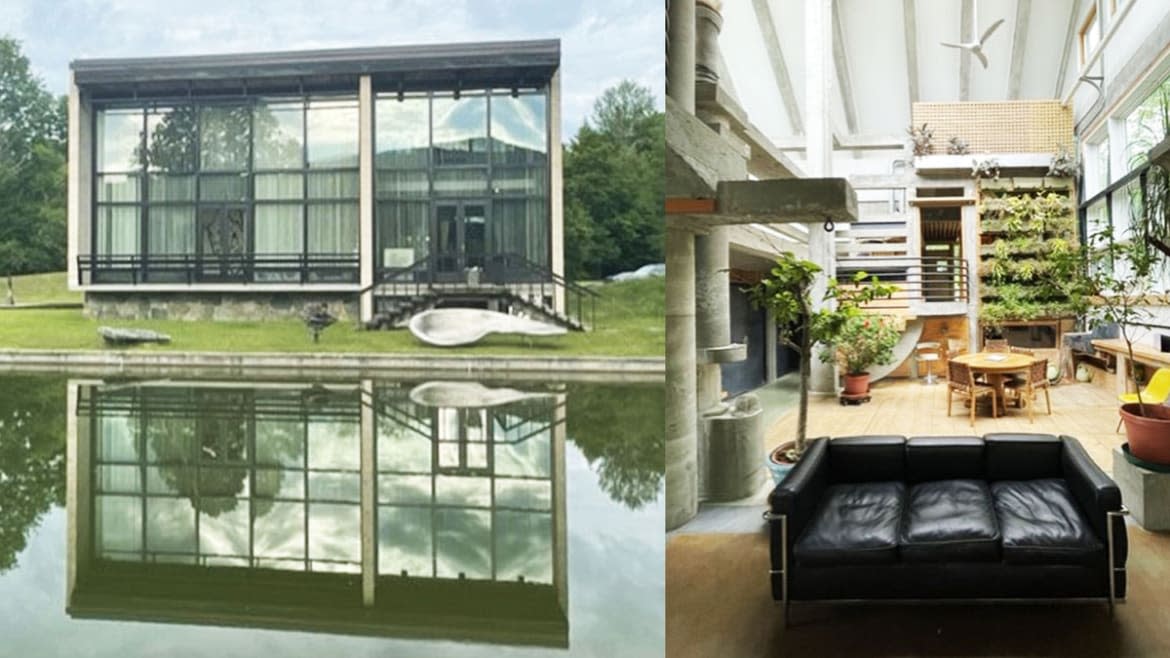
Some 20 miles south of Waterbury, near Sugarbush Resort, the standard image of Vermont pastoralism takes more than a few left turns. The area around Warren contains a unique cluster of DIY modern architecture built between 1965 and quite recently, poised somewhere between back to the land and back to the future. You can stay in some of the finest examples, in an experience guaranteed to be more adventurous than your usual homestays.
Architects frustrated with an absence of hands-on building in architectural practice began to cluster in the area in the mid-1960s, producing what is now a substantial grouping of experimental constructions. You can rent homes containing a dozen stairways, almost no hallways, sliding panels, a cantilevered kitchen, the most dramatic shower I’ve ever stepped in, and a Cat in the Hat stained glass window within a small area.
Dave Sellers, who moved to the area in 1965 and has been building there since, was frustrated by a lack of any practical education at Yale Architecture School, so set out to get his hands dirty, and learn a thing or two in Vermont.
Sellers’ first home–which was also the work of all sorts of other people, as collaboration exudes from its pores–was the Tack House, begun in 1965 and worked on over decades, which you can rent right now. The house is both rough-hewn and science fictional. The steampunk feeling is no surprise; it was never planned in its entirety but rather a gradual accretion, the product of a series of ad hoc design decisions and never any single moment.
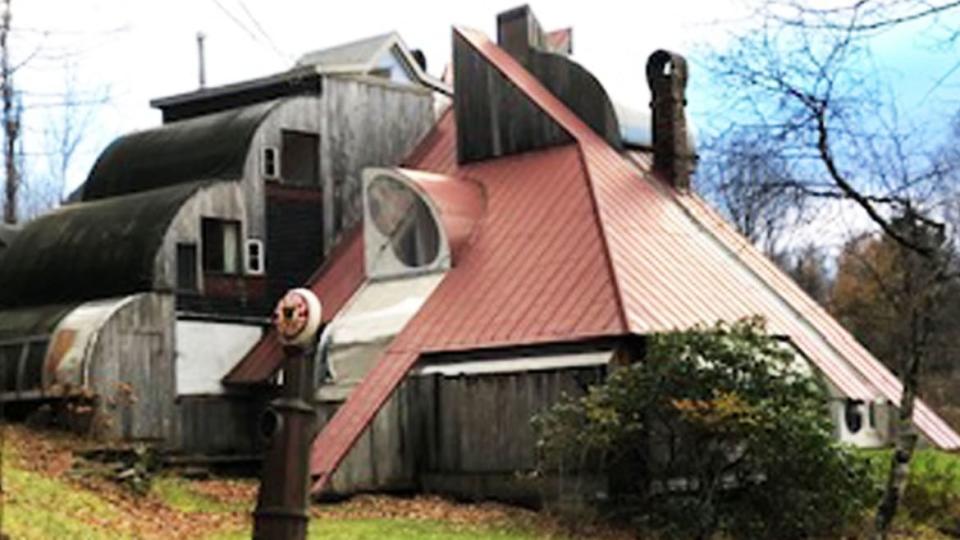
Tack House.
It’s a surreal experience. A friend and I were summoned in by the owner, Candy Barr, up a ladder, which is probably not the way you’ve entered most homes. Typical conceptions of space are out the window here; you’d be hard-pressed to describe where many rooms end and others begin. There’s a bunk bed directly over a shower overlooking a kitchen. Ladders and winding stairways twist through amorphous spaces; roof windows slant or bulge out. Windows and gaps are incised throughout.
Barr, an accomplished plein art painter who was formerly married to Sellers, has decorated numerous surfaces within the home. “During the entire time I lived there I was completing the inside. From wall and mosaic floor surfaces to lighting, storage, windows coverings and otherwise decor on the walls, including paintings and a mural,” she explained.
Sellers, Barr, and others were doing this themselves, not drawing up plans and handing them off to a contractor as was common practice. The frustrating paradox of architectural education, Sellers claimed, “it’s a set of instructions for telling someone else to do something that you don’t know how to do.” He set out to learn how.
Sellers’ “design-build” ethos was not merely about designing and building oneself, but also about improvising these steps as you went along. Typical construction is plotted out to the last fraction of an inch on paper; Sellers thought this quashed possibilities for doing better, for figuring out more intriguing uses for spaces once they’re partway built. Part of this, he explained, applied to rote designations of room functions. “What if you made a series of spaces with no function whatsoever and part of the problem was the feature? People will move into a barn or an old warehouse. What if you have some sensitive designers make a series of unusual spaces with light and then you figure out a way to live within it.”
And that’s just what Sellers did in the Tack House, inserting rooms in places you normally wouldn’t expect, and devising rooms that aren’t clearly one thing or another. Some of these involved a greater reach than others. There’s a cantilevered bump covered in plexiglass which was a necessary kink in order to fit kitchen appliances. Some of these things are odd, to put it mildly, but it’s an enthralling tweak of the age-old concept of a room being inexorably one functional thing that much recent building has encouraged.
Do not be put off by the quirks to these structures. I stayed in a property nearby with some very Prickly Mountain traits; an absence of doors and about three times the number of stairs you’d expect did not impede life or sleep–and all of this was bracing in contrast to square normcore homes. And you’re just testing it out–no mortgage required.
—
Sellers had a few strong influences. One lunch with Louis Kahn and another professor stood out. Kahn pointed out the end of a stainless steel silverware tray ballooning out from contact with the cutlery. He said, “You know something happens to materials when you change a tree to a chair or a bucket of liquid cement to a column. When it changes you have to know what it really can do.”
He cites another sculpture class offered by Robert Engman, a Josef Albers protégé at Yale, as key. A sculpture frequently wouldn’t be plotted out into its last details and would shift as one was working with the materials–unlike buildings. “What he did convinced me that you can't invent something in a design without knowing what the materials would do,” Sellers said.
He also took any chances he could to engage in, well, actual building. He worked removing concrete formwork from Eero Sarrinen’s Morse and Ezra Stiles colleges at Yale, devising a tool to speed the process. It worked–all too well–he was fired at the end of that day.
He had some summer work designing homes for a housing developer only to be informed they’d be too expensive. So he closely reviewed his lumber list and building practices. These expenses were soon no longer opaque. It’s an enduring triple-blind in homebuilding today. “The architect says ‘You never liked my work’, the owner says ‘I can’t afford it’ and the contractor says, ‘The architect doesn’t know what he's doing.’”
The Tack House was the first structure built on 400 acres of land on Prickly Mountain in Warren, which they bought for a $10,000 down-payment. He sold lots to like-minded peers, some building for themselves, others building weekend homes for the adventurous. It made a stir.
A number of these homes can be seen along Prickly Mountain Road, particularly its offshoot Loop Road, which contains homes by Sellers, his early partner Bill Reinecke, and other members of the Prickly Mountain pantheon. Drive by but remember these are private homes, do not dawdle, and do not trespass!
One amazing structure nearby, the Dimetrodon, was the work of five University of Pennsylvania architecture students drawn by Sellers’ model. Do not go there unless you’ve made arrangements, but enjoy photos online. This building borrows its name from a dinosaur and its concept from Japanese megastructures. Jim Sanford and Bill Maclay were two students at Penn lured by a Sellers talk at the school. They aimed for something big. Sanford explained, “We were fascinated by Japanese megastructures. Kenzo Tange and others were building these huge things into which people were plugging residential, commercial, and industrial elements. So we decided that we would build a giant structure into which people would build stuff.”
They built a large triangular frame into which residents then built their own homes. It’s still a fantastic work, combining relatively high-tech and cheap materials. The project was an innovator with regards to sustainability, with a wood boiler and active solar heating system and two wind turbines, generating much of its energy from natural means.
Bill Maclay noted this was one of the earliest solar projects in the country. It launched his lifelong building career of sustainable construction far before passive or net zero houses were even a concept. “Designing, building, and raising a family at Dimetrodon remains the turning point in my life. It came from a vision, purpose and path that is at the heart of my passion for working toward a thriving, healthy, and renewable planet and future for all living systems.” It was also relatively easy (with a base of knowledge) to do. “You don’t have to be a genius—act fast and figure it out later.”
The Prickly Mountain crew has been injecting fun into all sorts of things nearby. Sellers designed several rooms at the nearby Pitcher Inn in Waitsfield (Sanford also designed one), a demure-looking structure that contains their exuberant rooms, with a mock ski lodge as a bedroom within one suite and another goofily Masonic chamber.
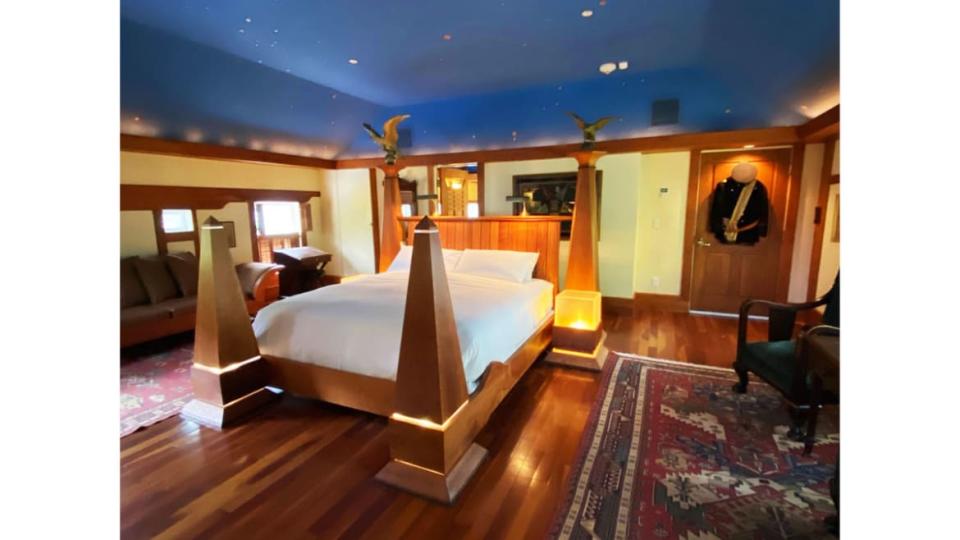
The Pitcher Inn.
His projects often lead into one another. He was leading a concrete class at the Yestermorrow Design School (another offshoot of the design-build boom, which offers classes in everything from tiny house to treehouse design housed in a building revamped by Maclay—visitors welcome!) and took formwork from the Inn which he used for a class project—and then kept building. He called it the Archie Bunker house, a joke I needn’t explain.
It’s more polished than the Tack House. Concrete requires a bit more planning than wood construction, you can’t carve things out as easily later. There’s a grand descent to the main double-height living area and a colonnaded view of the pool. A wall on wheels rolls away to provide seamless outdoors access; a bed also rolls into a wall. Sellers had fun with concrete in all sorts of ways: there’s a Corbusian barrel-vault ceiling and exterior column capitals were students’ homage to Carlos Scarpa.
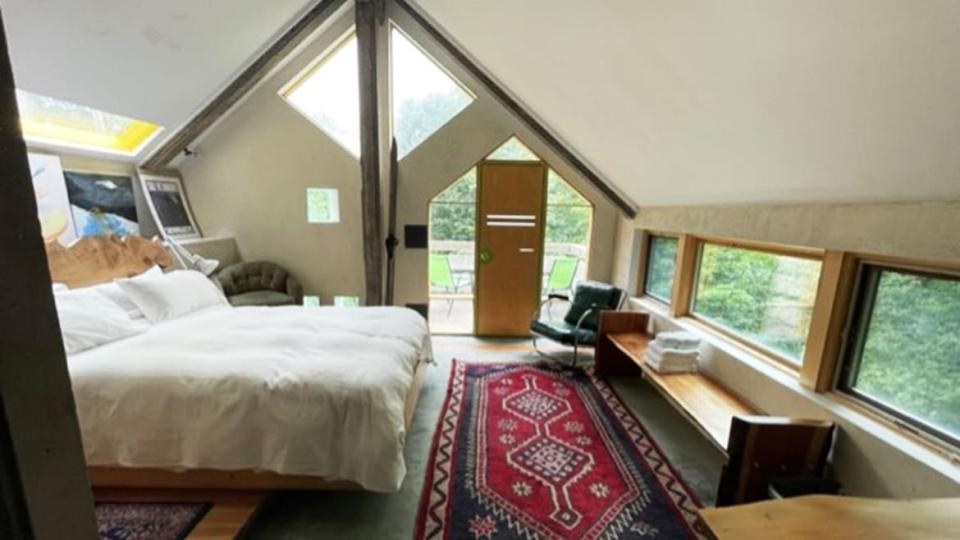
Archie Bunker House.
There are “rooms” here to a somewhat greater sense than prior work but incisions through space are legion. Colored plexiglass surrounds one bathroom (you can’t see in) becoming, as Sellers put it, “a lightbulb for the stairway.”
He became more interested in permanence. As an intense enthusiast for environmentally friendly construction, he worried that the most sustainable of houses won’t last if they don’t look good. “If a passive house is ugly and torn down 30 years later what use is that to the planet? If it’s well-done and beautiful it won’t go to the dump.”
There are all sorts of fun touches. A band of mirroring around the exterior; “When the snow comes up to the bottom of the mirror the house floats So now you have a 20-ton house hovering.”
There’s a Cat in the Hat stained glass window and a chess table with each leg modeled after great chess players—Fischer, Kasparov, Spassky, and IBM’s Deep Blue. His homes are stocked with great furniture, Eames and Morris chairs and their ilk.
Another of his homes nearby, the Home Run House, is available to rent. This is a grander sort of villa, with another dramatic double-height living space, and proportions that are comparatively palatial. A plant wall is fed by rainwater. Aluminum chases are found here, and enticing views all throughout. There’s another rolling wall. Columns and beams are in place for a possible third floor, but they look excellent just as they are.
Revenues from this home support another must-see in the area, the Madsonian Museum in Waitsfield which Sellers founded (these towns are located in the Mad River Valley, the title a play on the Smithsonian).
The museum’s ambiance is part flea market, part highbrow antique store, and features a collection whose range is difficult to imagine anywhere else. Sellers makes no distinctions about the kind of things that deserve display. There are Breuer and Eileen Grey and Gehry chairs but also vacuum cleaners, gumball machines, and chainsaws. There are also a few of his designs–I imagine you wouldn’t be surprised to find that he’s designed a sled.
The museum features all sorts of wonderful toys, which Sellers sees as a pinnacle of design, “It has to look cool, it has to be able to do something, it has to be well made and it has to last.” And most importantly, “it has to get the fantasy going.”
Sellers finds fun in a variety of objects and in their juxtaposition. A Maytag Wringer washing machine sits very deliberately near a case of droid figurines.
There are two impressive classic cars, A 1934 Chrysler DeSoto Airflow, one of six in existence, and a 1936 Cord Westchester sedan. Sellers had long wanted a DeSoto, and drove to Ontario to buy this one. The seller had been gifted this by his son. “I said ‘How’d you get that?’ He said, ‘See that little green shack by the lake? That’s where my son and John wrote The Blues Brothers.’ Then it dawned on me, ‘Your son is Dan Aykroyd.’”
The museum is a sustained advocacy of design across all categories. “The designers are the rock stars; they’re the last person in line to deal with the resources. Not only should they be the richest people in the world, everyone should know who they are.” It’s also a sustained argument against waste and for reuse, “a way to say to our species we can’t keep throwing stuff away.”
—
There’s a very different sort of modernism on hand right nearby, in the form of the Bundy Modern, a 1962 Miesian arts space built by Harvard architecture graduate and heir Harlow Carpenter (whose parents, on his urging, funded Le Corbusier’s Carpenter Center at Harvard). It eventually fell on rough years: it was vacant from 2009 to 2013. Owner and operator Wendell Anderson, who lives there with his wife, overheard mention of the space. “I drove up and climbed in. The grass was 3 feet high. There were birds flying around in the building. I walked around and I texted my wife and said I just found our next house.”

Bundy Modern.
They renovated a portion of the structure into the home but hold gallery shows from May to October each year. This started local but soon expanded. Wendell explained: “We did find that career artists who wouldn’t necessarily exhibit outside of Boston or New York would exhibit here.” Just text them for an appointment, they provided an extremely gracious tour.
Most of the original art is gone, much of it at fire-sale prices—a 7-foot Louise Nevelson piece was sold for $3,500–but numerous excellent original sculptures by Paul Aschenbach, Colombo Manuelli, Dino Basaldella, and others were retrieved and replaced around its grounds.
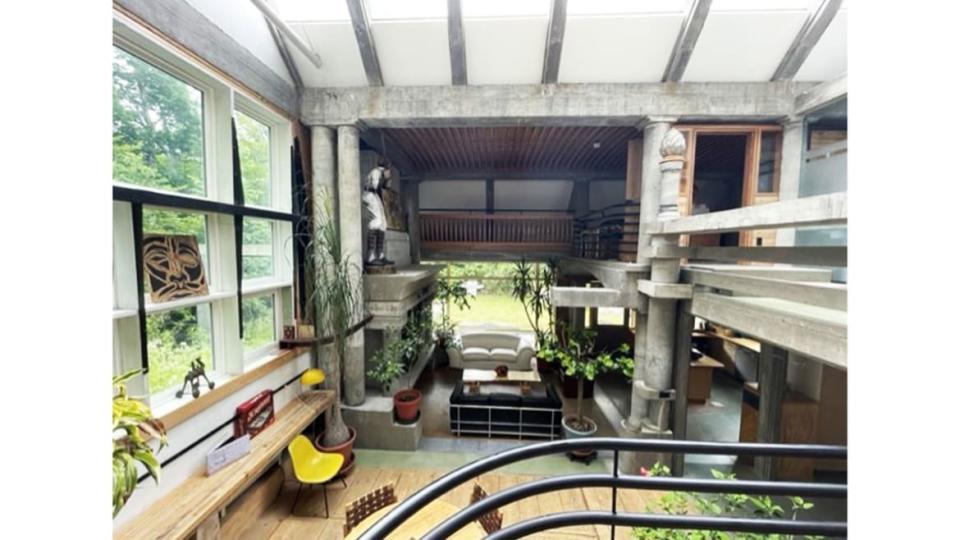
The Home Run House
I don’t need to tell you about Vermont’s natural attractions, but there are still more things to do nearby. The Hood Museum in Dartmouth and its library’s splendid Orozco mural are an easy trip. Burlington and the Dearborn Village-like museum panoply of the Shelburne Museum are close. Sellers built several wacky structures at Goddard college, also not far off.
You will see trademark Prickly Mountain modernism ranging around the area—and there’s a good chance you’ll run into the creators themselves, a shocking number of whom still live in the area (there’s a documentary in the works if you want to learn more).They were a community, and remained so, Sellers recounted. “The people who did that all had something in common. They were all trying to make something. That common attitude created a common neighborhood culture. It’s not a commune, it wasn’t a radical dropout thing either. The addiction was the opportunity to make something.”
Get the Daily Beast's biggest scoops and scandals delivered right to your inbox. Sign up now.
Stay informed and gain unlimited access to the Daily Beast's unmatched reporting. Subscribe now.

